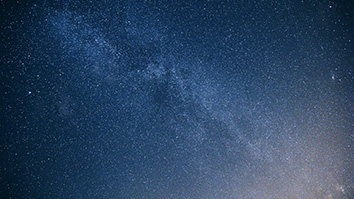
Researchers from SRI’s Center for Advanced Imaging will help design and build the next generation of space imagers for NASA’s Ultraviolet Explorer telescope.
In 2030, NASA is planning to launch a space telescope with a mission to survey ultraviolet light across the entire sky and provide new insights into the evolution of stars and galaxies. Here on Earth right now, SRI engineers are designing, and will ultimately build, the imagers that NASA’s Ultraviolet Explorer (UVEX) will use to generate a detailed map of ultraviolet sky.
“Our expertise is in custom-made cameras for space exploration,” said David Keller, Director of the Center for Advanced Imaging at SRI. “The imagers for UVEX represent the next generation of our proven technology and will help us learn more about our universe.”
Taking ultraviolet telescopes to the stars
SRI is providing the imagers for two focal plane modules (FPM) consisting of an array of complementary metal oxide semiconductor (CMOS) imagers for UVEX to provide a unique opportunity to survey ultraviolet activities that are more than 50 times more sensitive than NASA’s previous ultraviolet survey telescope, which was decommissioned in 2013.
One imager will be tuned to capture near-ultraviolet light, which has a longer wavelength and is closer to visible light; the other will be tuned to capture far-ultraviolet light, which has a shorter wavelength and higher energy. In addition, UVEX will use a similar camera to capture the light from a spectrograph, which disperses the light from a single galaxy across the camera. Together, these imagers will be used to conduct a full-sky survey, mapping ultraviolet signatures in space.
Researchers hope to identify nearby galaxies that are just forming their first stars as well as explosive phenomena that produce UV “flashes” across the night sky.
“SRI’s expertise is in custom-made cameras for space exploration.” — David Keller
In addition to its survey mode, UVEX will re-orient to investigate newly discovered sources of ultraviolet light. This will help scientists learn more about transient events, such as supernovae. The spectrum of ultraviolet light given off in the early days of a supernovae can help scientists understand chemical compositions of exploding stars.
Creating technology to withstand space
Each of the UVEX focal planes will contain nine SRI imaging chips packed with light-sensing pixels laid out in a 4096 x 4096 array. Collaborators at NASA’s Jet Propulsion Laboratory will add a special coating to the chips that help process the specific near-ultraviolet and far-ultraviolet wavelengths.
“They’re like computer chips with integrated circuits, except these take photons of light and convert them to electrical energy, which we generate a picture out of,” Keller said. “It’s a fancy version of what’s in a Digital Single Lens Reflex camera.”
Once the chips are manufactured, SRI will assemble them into custom packages and run them through extensive testing to make sure that they can withstand intense heat, extreme cold, vacuum, and radiation conditions of space. When the imagers have passed every test, they will be transferred to colleagues at Caltech and NASA for use on UVEX.
Making history for future generations
Earlier versions of SRI’s CMOS imagers are orbiting the sun in NASA’s Parker Solar Probe and the European Space Agency’s Solar Orbiter, gathering data on the sun’s corona to help understand and forecast solar weather events. SRI has also supplied its CMOS imagers for NASA’s upcoming Europa Clipper mission, which is slated to launch this October.
The spacecraft will spend six years traveling to Jupiter, where it will use SRI’s imagers to map almost the entire surface of Jupiter’s moon Europa in greater detail than ever before.
“The technology we’re building is being used to expand our knowledge in deep science, space exploration, and to provide information about earth and space weather that we don’t fully understand yet,” Keller said.



